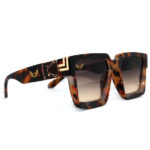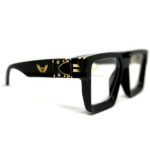Sunglasses have become a popular accessory in recent years, not only for their stylish designs but also for their ability to protect eyes from harmful ultraviolet (UV) rays. Sunglasses are available in a variety of styles, colors, and shapes, making them a versatile fashion accessory. In this guide, we will discuss the different types of sunglasses, their benefits, and how to choose the right pair for your needs.
Types of Sunglasses
1. Polarized Sunglasses
Polarized sunglasses have a special filter that reduces glare from surfaces such as water, snow, and glass. They are ideal for outdoor activities such as fishing, boating, and skiing. Polarized lenses are designed to block horizontal light waves, which reduces glare and provides better visual clarity. Polarized sunglasses also protect your eyes from harmful UV rays, which can cause damage to your eyes over time.
2. UV400 Sunglasses
UV 400 sunglasses are designed to provide protection from harmful ultraviolet (UV) rays from the sun. The term “UV 400” refers to the lenses’ ability to block all UV rays with wavelengths up to 400 nanometers, including UVA and UVB rays. UV radiation can cause damage to the eyes, including cataracts, macular degeneration, and even skin cancer around the eyelids. UV 400 sunglasses are an effective way to protect your eyes from these harmful effects. When purchasing sunglasses, it’s important to look for those that offer UV 400 protection and to wear them whenever you are exposed to sunlight. It’s also important to note that the darkness of the lens does not necessarily indicate the level of UV protection provided, so be sure to check the label or ask your optometrist for advice on selecting the best sunglasses for your needs.
3. Mirrored Sunglasses
Mirrored sunglasses have a reflective coating on the lenses that reduces the amount of light that enters your eyes. They are ideal for outdoor activities such as hiking, biking, and skiing. Mirrored sunglasses are available in a variety of colors, including silver, blue, and red. They also provide protection against UV rays and glare.
4. Gradient Sunglasses
Gradient sunglasses have lenses that are tinted darker at the top and lighter at the bottom. They are ideal for driving, as they provide protection from the sun’s glare without obstructing your vision. Gradient sunglasses are also popular for their stylish designs, as the tinted lenses can be made in a variety of colors.
5. Photochromic Sunglasses
Photochromic sunglasses have lenses that change color based on the amount of UV light they are exposed to. They are ideal for outdoor activities as they provide protection against UV rays and glare. Photochromic sunglasses are available in a variety of colors, including brown, gray, and green. They also provide visual clarity in different lighting conditions.
6. Sports Sunglasses
Sports sunglasses are designed for outdoor activities such as cycling, running, and golf. They are lightweight and durable, with lenses that provide protection against UV rays, glare, and impact. Sports sunglasses are also available in a variety of styles and colors, making them a popular fashion accessory.
Benefits of Wearing Sunglasses
1. Protection Against UV Rays
One of the primary benefits of wearing sunglasses is protection against harmful UV rays. UV rays can cause damage to your eyes over time, leading to cataracts, macular degeneration, and other eye diseases. Sunglasses with UV protection can prevent these conditions from occurring.
2. Reduced Glare
Sunglasses with polarized lenses can reduce glare from surfaces such as water, snow, and glass. This makes them ideal for outdoor activities such as fishing, boating, and skiing.
3. Improved Visual Clarity
Sunglasses with high-quality lenses can provide improved visual clarity, making it easier to see in different lighting conditions. This is especially important for driving, as glare from the sun can impair your vision and make it difficult to see the road.
4. Protection Against Dust and Debris
Sunglasses can also protect your eyes from dust and debris, which can cause irritation and discomfort. This is especially important for people who work outdoors or participate in outdoor activities.
How to Choose the Right Sunglasses
Consider the Shape of Your Face
When choosing sunglasses, it’s important to consider the shape of your face. Different styles of sunglasses are better suited to different face shapes:
1. Round Face
If you have a round face, choose sunglasses with angular frames, such as square or rectangular frames, to add definition to your face.
2. Oval Face
If you have an oval face, you can wear almost any style of sunglasses. Look for frames that are proportional to your face and enhance your features.
3. Square Face
If you have a square face, choose sunglasses with round or oval frames to soften the angles of your face.
4. Heart-Shaped Face
If you have a heart-shaped face, choose sunglasses with wide, rounded frames to balance your features.
5. Triangular Face
If you have a triangular face, choose sunglasses with wide frames and a rounded bottom to balance your features.
Consider the Lens Color
Lens color can affect your visual clarity and perception of color. It’s important to choose the right lens color based on your needs and the activities you will be doing.
1. Gray Lenses
Gray lenses are a popular choice for sunglasses as they provide natural color perception and reduce brightness without distorting colors.
2. Brown Lenses
Brown lenses enhance contrast and depth perception, making them a good choice for outdoor activities such as hiking and fishing.
3. Green Lenses
Green lenses are ideal for outdoor activities as they enhance contrast and provide natural color perception.
4. Yellow Lenses
Yellow lenses are ideal for low-light conditions as they increase contrast and depth perception.
5. Blue Lenses
Blue lenses are a good choice for bright and sunny conditions as they reduce glare and provide natural color perception.
6. Rose Lenses
Rose lenses enhance contrast and are particularly useful for water sports such as fishing and boating.
Choose the Right Frame Material
The frame material of your sunglasses is just as important as the lenses. Here are some of the most common materials used for sunglass frames:
1. Metal Frames
Metal frames are durable and lightweight, making them a popular choice for sunglasses. They can be made from materials such as titanium, aluminum, and stainless steel.
2. Plastic Frames
Plastic frames are available in a variety of colors and styles, making them a popular choice for fashion sunglasses. They are also lightweight and durable.
3. Nylon Frames
Nylon frames are lightweight and flexible, making them a good choice for sports sunglasses.
4. Wood Frames
Wood frames are a sustainable and eco-friendly choice for sunglasses. They are also lightweight and durable.
Tips for Taking Care of Your Sunglasses
1. Keep Them Clean
Clean your sunglasses regularly with a microfiber cloth and lens cleaner to prevent scratches and maintain visual clarity.
2. Store Them Properly
Store your sunglasses in a protective case when not in use to prevent scratches and damage.
3. Avoid Extreme Temperatures
Avoid leaving your sunglasses in extreme temperatures, such as in a hot car or on a freezing surface, as this can damage the lenses and frames.
4. Don’t Use Your Shirt to Clean Them
Using your shirt or other clothing to clean your sunglasses can scratch the lenses and damage the coatings.
Lens Technology
Apart from protecting your eyes from harmful UV rays, sunglasses come in different lens technologies designed to enhance your vision and give you a better experience. One of the most popular types of lens technology is polarized lenses. These lenses are designed to reduce glare from reflective surfaces such as water, snow, or glass. Polarized lenses use a special filter that blocks out light waves that are horizontally polarized, which in turn reduces glare and improves visual clarity. Polarized lenses are particularly useful for outdoor activities such as fishing, boating, and driving, where glare from the sun or other reflective surfaces can be particularly distracting.
Another type of lens technology is photochromic lenses. Photochromic lenses change their tint according to the amount of UV light they are exposed to. These lenses are particularly useful for people who are sensitive to bright light or for those who frequently move in and out of different lighting conditions. Photochromic lenses darken when exposed to bright sunlight and become lighter when the sun goes down or when you enter a shaded area. These lenses are available in both prescription and non-prescription sunglasses.
Frame Styles
Sunglasses come in a wide range of styles, each designed to suit different face shapes and fashion preferences. Here are some of the most popular sunglass styles:
- Aviator: Aviator sunglasses have a teardrop shape and were originally designed for pilots. They have since become a popular fashion accessory and are particularly flattering for people with heart-shaped faces.
- Wayfarer: Wayfarer sunglasses have a classic square shape and are one of the most popular sunglass styles. They are particularly popular for their retro look and are flattering for people with round faces.
- Round: Round sunglasses have a circular shape and are particularly popular for their vintage look. They are flattering for people with square faces.
- Cat-eye: Cat-eye sunglasses have a distinct pointed shape and are particularly popular for their feminine and glamorous look. They are flattering for people with oval and heart-shaped faces.
- Sports: Sports sunglasses are designed for outdoor activities such as running, cycling, and skiing
When choosing sunglasses, it’s important to consider the fit and comfort of the frames. Sunglasses that are too tight or too loose can cause discomfort, headaches, and even pain. Here are some tips to help you find the right fit:
- Look for frames that sit comfortably on the bridge of your nose without slipping down.
- Choose frames that are the right size for your face. Frames that are too big or too small can be uncomfortable and look unflattering.
- Look for frames with adjustable nose pads or temples. These can help you achieve a more customized fit.
- Consider the weight of the frames. Lightweight frames can be more comfortable for extended wear.
Prescription Sunglasses
If you wear prescription glasses, you don’t have to sacrifice style for function. Prescription sunglasses are available in a wide range of styles, from classic aviators to trendy cat-eye frames. Here are some things to keep in mind when shopping for prescription sunglasses:
- Make sure your prescription is up to date. If you’re not sure, schedule an eye exam with your optometrist.
- Choose frames that are compatible with your prescription. Not all frames can accommodate all prescriptions, so be sure to check with your eye doctor.
- Consider adding polarized or photochromic lenses to your prescription sunglasses for added protection and comfort.
- Shop around for the best price. Prescription sunglasses can be expensive, so it’s worth taking the time to compare prices from different retailers.
Caring for Your Sunglasses
To get the most out of your sunglasses, it’s important to take good care of them. Here are some tips to help you keep your sunglasses in top condition:
- Store your sunglasses in a case when you’re not wearing them. This can help protect them from scratches and damage.
- Clean your sunglasses regularly with a soft, lint-free cloth. Avoid using paper towels or tissues, as these can scratch the lenses.
- Use a mild soap or lens cleaner to clean your lenses. Avoid using harsh chemicals or abrasives, as these can damage the lenses.
- Don’t leave your sunglasses in a hot car or other areas with extreme temperatures. This can damage the lenses and frames.
- Avoid placing your sunglasses face down on hard surfaces. This can scratch the lenses.
Sunglasses and Sports
Sunglasses can be an important accessory for athletes and sports enthusiasts. Here are some things to consider when choosing sunglasses for sports:
- Look for sunglasses with shatterproof lenses. This can help protect your eyes from impact during high-contact sports.
- Choose sunglasses with polarized lenses for outdoor sports, such as fishing or skiing. Polarized lenses can reduce glare and improve visibility in bright sunlight.
- Consider wraparound frames for sports that require a lot of movement, such as running or cycling. Wraparound frames can help keep your sunglasses in place and protect your eyes from wind and debris.
- Choose lightweight frames for sports that require a lot of movement. Heavy frames can be uncomfortable and cause headaches or pain.
- Look for frames with rubber or silicone nose pads and temple tips. These can help keep your sunglasses in place during intense activity.
Sunglasses and Children
Children’s eyes are particularly susceptible to UV damage, so it’s important to choose sunglasses with proper UV protection for kids. Here are some things to consider when shopping for sunglasses for children:
- Look for sunglasses with UV-400 or 100% UV protection. This can help protect your child’s eyes from harmful UV rays.
- Choose sunglasses with durable, shatterproof lenses. Children are often more active and prone to accidents, so it’s important to choose sunglasses that can withstand impact.
- Look for sunglasses with wraparound frames. Wraparound frames can help keep the sunglasses in place and protect your child’s eyes from wind and debris.
- Choose sunglasses with adjustable nose pads or temple tips. This can help you achieve a more customized fit for your child.
- Consider choosing fun, colorful frames or lenses to make wearing sunglasses more appealing to children.
Sunglasses and Fashion
Sunglasses can be a stylish accessory that can complement any outfit. Here are some fashion tips for choosing sunglasses:
- Consider your face shape when choosing sunglasses. Different frames can flatter different face shapes, so it’s important to choose a frame that complements your face.
- Look for sunglasses that complement your personal style. Whether you prefer classic, timeless styles or trendy, bold frames, there’s a pair of sunglasses out there for you.
- Choose sunglasses with lenses that match your skin tone. Warmer skin tones can look best with brown or amber lenses, while cooler skin tones can look best with gray or green lenses.
- Consider the color of your clothing when choosing sunglasses. Black or neutral frames can go with any outfit, while colored frames can add a pop of personality to your look.
- Don’t be afraid to experiment with different styles and colors to find the perfect pair of sunglasses for you.
Sunglasses and Medical Conditions
Some medical conditions can require special considerations when choosing sunglasses. Here are some things to keep in mind:
- People with cataracts may require special lenses that block certain wavelengths of light. Talk to your eye doctor about the best options for you.
- People with macular degeneration may require sunglasses with yellow-tinted lenses to improve contrast and visibility.
- People with dry eyes may benefit from sunglasses that wrap around the face to help protect the eyes from wind and dust.
- People with light sensitivity or migraines may benefit from sunglasses with polarized lenses or lenses with a rose tint.
To Conclude the Sunglasses Ultimate Guide
Sunglasses are a versatile accessory that can protect your eyes from UV damage, enhance your vision, and complement your personal style. When choosing sunglasses, consider your intended use, face shape, personal style, and any medical conditions that may require special considerations. With so many styles, colors, and lens technologies to choose from, there’s a perfect pair of sunglasses out there for everyone. By following these tips, you can find the perfect pair of sunglasses to protect and enhance your vision, while looking stylish and feeling comfortable in a pair of Shari Dionne sunglasses!
Citations:
- American Academy of Ophthalmology. Sunglasses: A Guide to UV Protection. 2019. Available at: https://www.aao.org/eye-health/tips-prevention/sun. Accessed April 28, 2023.
- The Vision Council. Polarized Lenses. 2020. Available at: https://www.thevisioncouncil.org/resources/polarized-lenses/. Accessed April 28, 2023.
- American Optometric Association. Photochromic Lenses. 2021. Available at: https://www.aoa.org/patients-and-public/caring-for-your-vision/protecting-your-vision/sunglasses/photochromic-lenses?sso=y. Accessed April 28, 2023.
- The Vision Council. Lens Colors. 2020. Available at: https://www.thevisioncouncil.org/resources/lens-colors/. Accessed April 28, 2023.
- “Ultraviolet (UV) Radiation.” American Cancer Society. Accessed April 29, 2023


